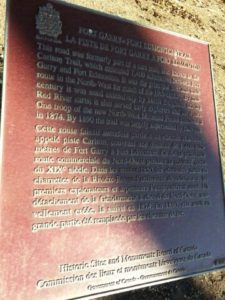
7 PETRO-CANADA HERITAGE PARK | OLD CART TRAIL MARKER, 1998
It is said that the first three languages spoken in the original Fort Edmonton (1795) were Cree, French, and Gaelic. The French-speaking fur traders, whether the early coureurs-des-bois or the far-reaching voyageurs, had to connect with the Indigenous Nations to survive and tap into their trade networks to succeed in their search for furs. The French-Canadians, and Scottish men of the Hudson’s Bay Company formed relationships with the Indigenous women, and many married. These families established distinct and growing communities with their own unique culture, language (Michif), and collective consciousness – forming the distinct Métis Nation.
Although 1876 brought Treaty No. 6, racism, competition for resources, and religious oppression were part of the political climate, and a paternal and oppressive agenda of assimilation became Canadian law that same year. The Canadian Indian Act denied “Indians” the right to vote, choose the fate of their land, freely sell farm products, or purchase firearms. It forced Indigenous Peoples onto reserves with restricted departure, restricted their access to farming equipment, forced children into residential schools, and forbade public use of native languages and cultural traditions. Amendments to the Act in 1951 and 1985 removed some discriminatory sections, but many systemic issues remain. In 2008, the Prime Minister delivered an apology to Indigenous Peoples of Canada, and the Truth and Reconciliation Commission began its work.

Sources: treatysix.org, Treaty 6 Education, Truth and Reconciliation Commission of Canada (TRC), Full text of “Royal Commission on Aboriginal Poples – Final Report – Vol. 1 – Looking forward looking back”, Candas Jane Dorsey (Personal Correspondence), Tom Long (Personal Correspondence)
Photo Credits: Ester Malzahn
